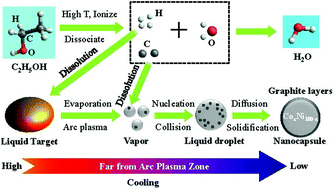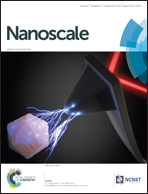CoxNi100−x nanoparticles encapsulated by curved graphite layers: controlled in situ metal-catalytic preparation and broadband microwave absorption†
Abstract
We report a one-step approach for preparing dispersive CoxNi100−x nanoparticles completely encapsulated by curved graphite layers. The nanoparticles were prepared by evaporating Co–Ni alloys and the shell of graphite layers was formed by in situ metal-catalytic growth on the surface of nanoparticles whose layer number was controlled by tuning the Co content of the alloys. By modulating the composition of the magnetic core and the layer number of the shell, the magnetic and dielectric properties of these core/shell structures are simultaneously optimized and their permeability and permittivity were improved to obtain the enhanced electromagnetic match. As a result, the bandwidth of reflection loss (RL) exceeding −20 dB (99% absorption) of the nanocapsules is 9.6 GHz for S1, 12.8 GHz for S2, 13.5 GHz for S3 and 14.2 GHz for S4. The optimal RL value reaches −53 dB at 13.2 GHz for an absorber thickness of 2.55 mm. An optimized impedance match by controlling the growth of the core and shell is responsible for this extraordinary microwave absorption.


 Please wait while we load your content...
Please wait while we load your content...